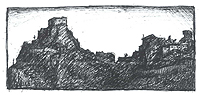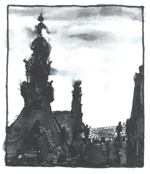Jayne Waterford
26 July 2001
 | Enzo Santoro
The Twain
116 Smith Street
Summer Hill
+61 2 9716 5190 |
Currently, the Twain is showing drawings and paintings from Enzo Santoro's most recent European Odyssey. He is a spiritual man of Sicilienne heritage who was born on the North Shore and currently lives in Summer Hill. He is drawn to landscape. The majority of the works displayed are taken from the sketch book he used on his journey. Most of the images are compositions of dramatic architecture like Norman Castles, Cathedrals and large Venetian buildings, others with spires and domes. These edifices are played on by the light in a way that moves the viewer in a poetic sense, a classic sense, an interaction that has been going on between the viewer and a manner of art for all time.
Santoro's heart is after the atmosphere in landscape where the light in a scene evokes a feeling. The works has, "lots to do with light and the way you experience light", the light that illuminates a place in a way that elevates the experience of seeing beyond an ineffectual object. This is usually a scene lit by the sun as it leaves at the end of a day. A small ink and wash drawing of Dresden on a grey and wet day not only carries a scene that transfixes. It also conveys the dark and sooty trauma of the place through wild contrast where light glances off a rooftop like an impenetrable mirrored surface.

Norman Castle |

Dresden |
Santoro is motivated by what he sees as an eternal feeling of art through the ages where people have always stood before great works, moved by the scene before them as they would be moved by the late afternoon sun, an eternal way of being. He empathises strongly theological works of Augustine and Aquinas because both work out the eternal law. Augustine works out this sense of eternal law in his very personal way through his conversion from Manacheism to Christianity as told in his very moving Confessions. He realigns himself to the universal truth as personified in the life of Jesus Chirst.
Aquinas on the other hand, nuts out a fabulous theology enduring enough for him to be declared the church theologian four centuries after his death, using the logic and reason that created the scholastic mould of his day.

Austria
The thought of these awesome European figures touches Santoro in face of a post modern society. For him they convey the truth that our own nature does not change over time, that our experience is not just cultural but enduring.
Santoro admires artists like John Olsen, Emily Kame Kngwarrie and Giotto. He is inspired by Olsen's beautiful landscapes because of his use of light, evident in his colour and the strong sense of movement and growth in the searching nature of his line. It's lyrical nature appeals to the musician and Santoro. For Santoro, Olsen paints the experience of being in the landscape, not the external prospect but the totality of the experience.
Kngwarrie's highly abstract dots and amkrk making convey a strong sense of light, mostly in her colour. Giotto's Life of Chrsit, hanging in the Basillica of St Francis in Assisi paints a very strong and luminous light that has had a very deep impact on Santoro, both artistically and spiritually.
His paintings are, in this person's opinion, the best works. His simple colouration and brushwork owes a lot to Lloyd Rees who also had thoughts about the eternal nature of light. An example is the gold spot-lit facade of the building in Venice. Santoro saw the tableau as he was getting on a ferry. He had to get off to draw it. The colours so impressed him that he was able to produce this painting 6 months after the event which is impressive as the image is so fresh: as if produced in situ.
Enzo Santoro can be found at: +61 2 9799 6860






